Songbird Nest Box Monitoring Report 2023
What were you doing in the summer of 2023?
From early March to early August, every week, our Restoration Biologist, Felicia Wang, along with interns and volunteers were (with great care) peeking into nest boxes, counting eggs and feathers and crossing their fingers as fledglings took to the air.


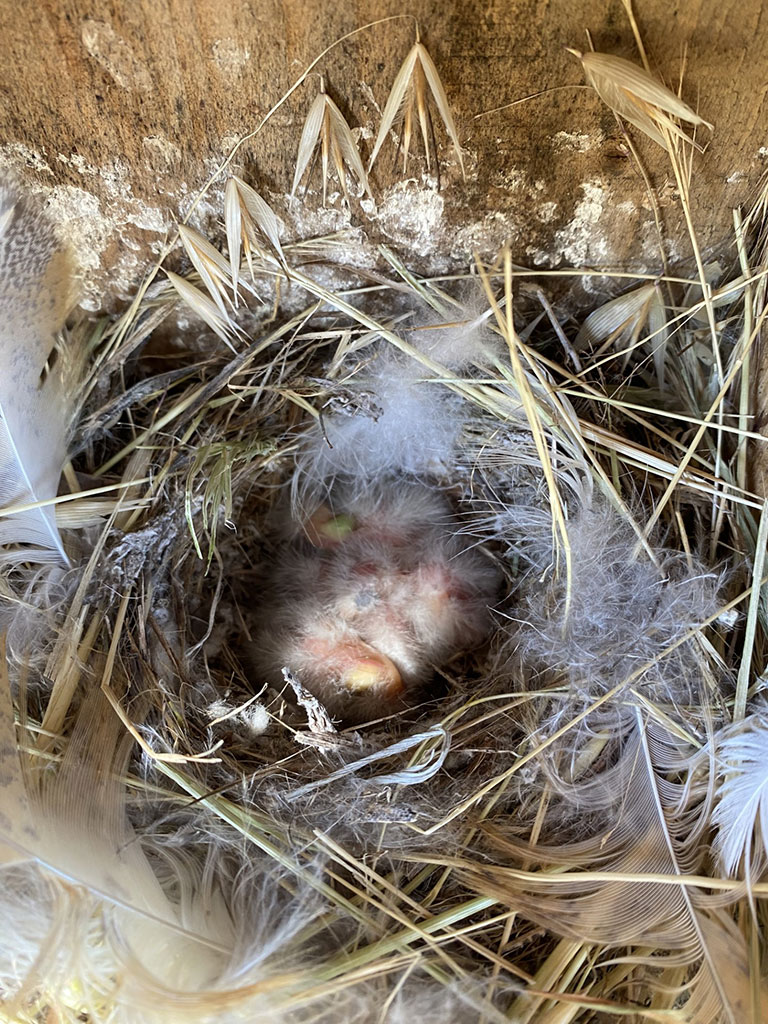
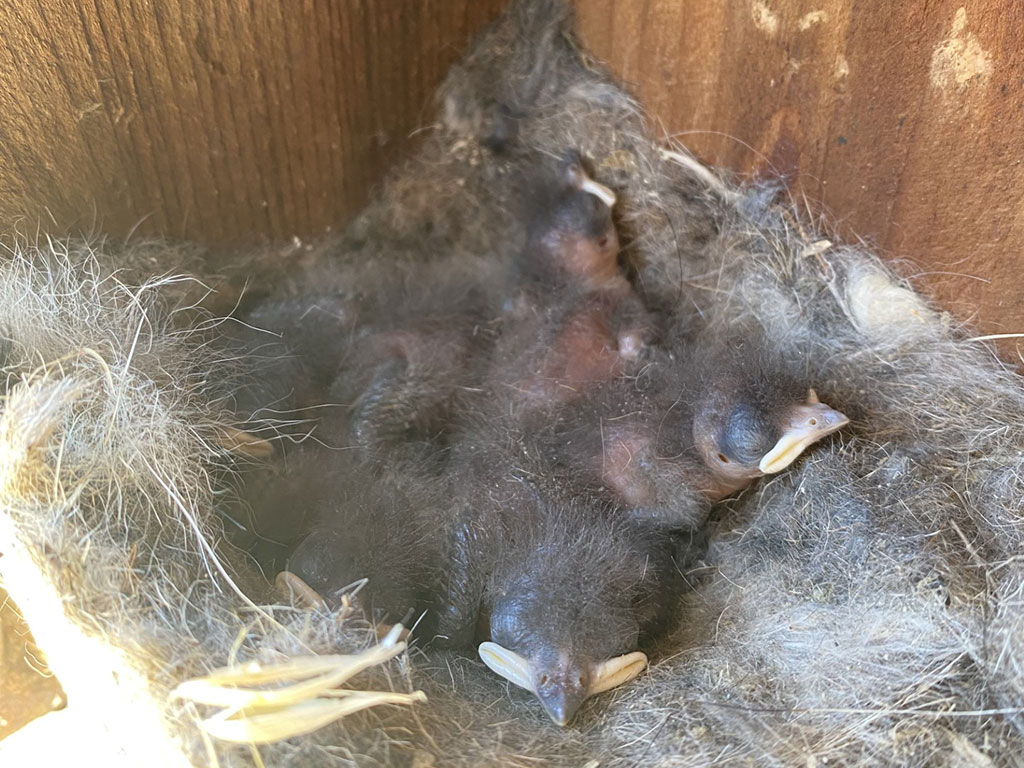
The Conservancy’s Nest Box program got its real start in 2021-22 when Harnawaz Boparai was here. Bird Nest Boxes are a great tool for both monitoring restoration projects and improving the diversity of the watershed. They are inexpensive and attract all sorts of cavity-nesting birds; songbirds, ducks, owls and other raptors and waterfowl. Birds are excellent harbingers of success or failure of a habitat. They indicate whether the habitat has sufficient food, water, shelter, acreage and the other resources that birds need to thrive.
The Conservancy manages a total of 40 nest boxes at the Nature Preserve (CCNP). Fifteen are for the songbirds. The rest are for wood ducks, northern flicker, kestrel/screech-owl, and barn owl. We also manage 15 boxes at the Capay Open Space Park (COSP) and three new boxes at Granite-Woodland Reiff (GWR), a conservation easement downstream from CCNP.
This article is meant to be an educational article for students, aspiring Naturalists, Citizen Scientists and birding enthusiasts. Professional scientists and researchers can download the original report, 2023 Songbird Nest Box Monitoring Report by our Restoration Biologist, Felicia Wang.
The article highlights an important finding revealed by the project.
Local, Native Songbirds
Some of the songbirds one can expect to find in our region include
- Tree Swallows
- House Finches
- Western Bluebirds
- Ash-throated Flycatchers
- White-breasted Nuthatch
- House Wren
At the CCNP, Tree Swallows and Ash-throated Flycatchers were the successful songbirds. Here’s what they look and sound like.
Tree Swallows
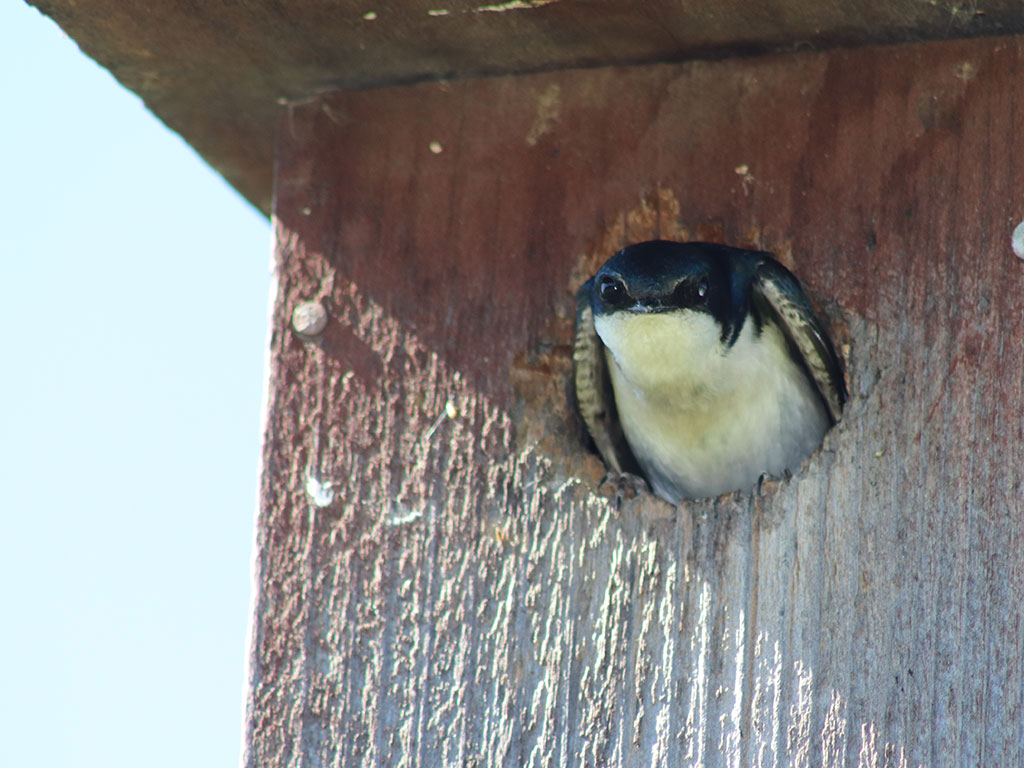
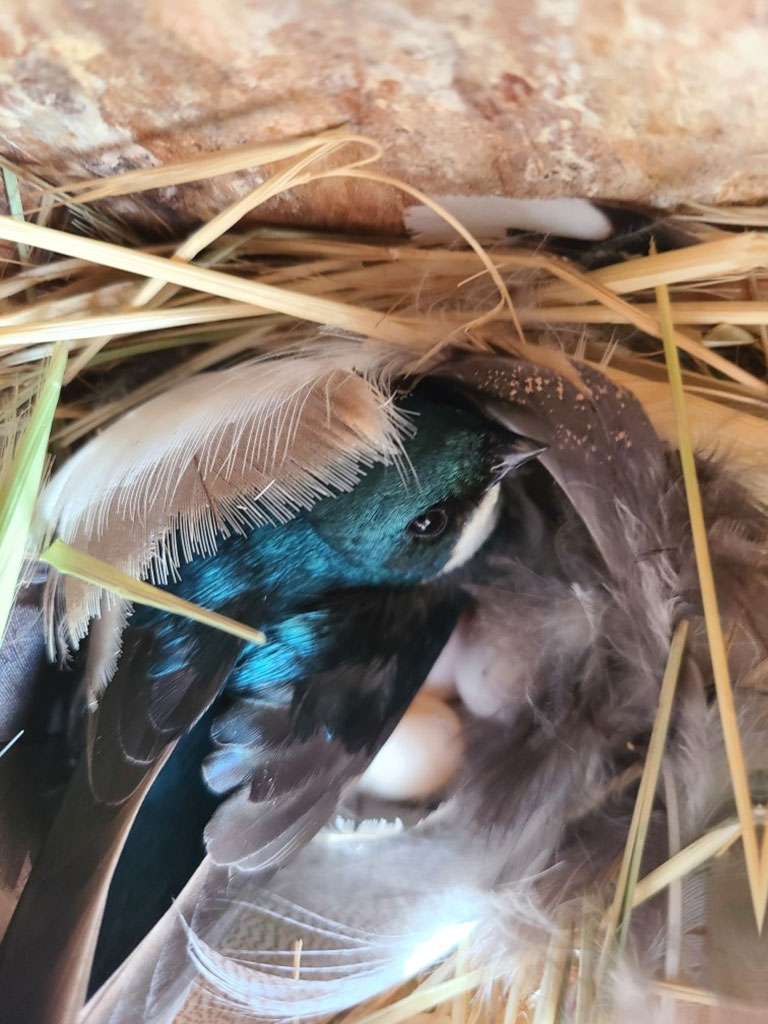
Tree Swallows migrate to breed along the west coast and all along the northern US and in Canada. They are an iridescent blue on the top. You can learn a lot, find out how to build you own backyard nest boxe and hear their sounds at Cornell Labs All About Birds webpage.
Ash-Throated Flycatchers
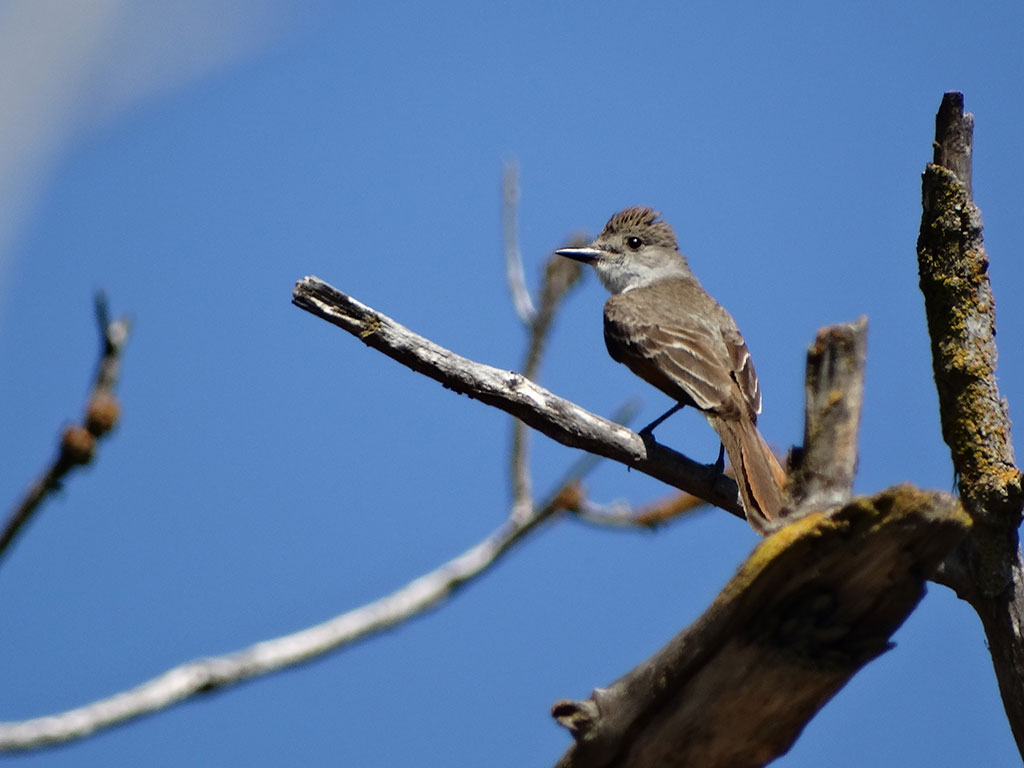
Ash-throated Flycatchers also migrate and end up in the southwestern US to breed. Notice the cinnamon-colored tail and tufted head. Apparently, they sing all day long.
Again, you can learn all about them at Cornell Lab’s All About Birds. You will also find instructions to build your own nesting box.
Now let’s get into the science of nest box breeding!
Collecting the Data
In the scientific method, the type of data collected is carefully planned by the researcher to answer specific questions.
For this project, the monitoring team collected the following data.
- Species
- Status and stage of the nest
- Number of feathers for Tree Swallow nests*
- Number of eggs laid
- Relative temperature of the eggs (warm or cold)
- Number of eggs hatched
- Number of young fledged
- Status of the parents (around, in/out of the box, or absent)
- Presence of parasites
- Approximate age of the nestlings if possible
- Re-nesting attempts
* The number of feathers tells us how close the nest is to completion. More feathers (>15) means the nest is very close to if not already complete and we should expect to see eggs very soon.
Please note: All activities were conducted by trained individuals. Please do not attempt to handle wild birds or their nests yourself. It may harm the bird families and in some cases are illegal.
Metrics and Inferences
The data collected allows for the comparison and contrast of breeding success between breeding seasons and nest box locations. But first, raw data must be turned into useful metrics that will allow the researcher to make inferences about the success of the bird communities and what might be done to improve them.
Metrics
The term “metric” has a lot of meanings depending on what field you are in. In scientific research, metrics are calculated results that serve as tools to help make comparisons. They are numbers rather than opinions or statements.
To infer
Inferences come from the act of deducing or concluding something from evidence and reasoning rather than from statements or opinions. You can infer there are Tree Swallows around when you hear their sounds.
Once the raw data is collected, the biologist becomes a “data analyst” who “crunches the numbers”, as they say. For this project, the following metrics were produced from the data. You can see details and graphs of these results in the original report, which you can download below.
- Total number of eggs, nestlings and fledglings
- Hatching and fledging rates
- Species diversity number
- Species evenness
- Occupancy rate
- Re-nesting rate
Each one of these metrics, and the inferences drawn from them, could be an article on its own. For this article, we will focus on Hatching and Fledging Rates.
Hatching and Fledging Rates
Absolute numbers (the raw data) don’t let us compare breeding success between years or between sites as well as the rates of hatching and fledging. The rate formula gives us how many hatchlings per eggs and how many fledglings per hatchling. This is like the rate of a car which gives you miles per hour or mph.
For example, if you only had 5 bird families with a 100% hatching and fledging rate, you could infer that the situation for them was better than for a group of 50 bird families with only a 20% hatching and fledging rate–even though the small group produced just a few fledglings and the big group produced many fledglings.
Hatchlings or Nestlings
Used interchangeably, these terms refer to newly hatched birds or birds that have not developed their flying feathers. They are still being fed and cared for by their parents.
Fledglings
Fledglings have developed their flying wings and are ready to leave the nest. Leaving the nest is called “fledging”.
Here is the real world data and rates for the different nest box locations.
CCNP
| Year | Number of eggs | Hatchlings per eggs | Hatching Rate | Fledglings per hatchlings | Fledging Rate |
|---|---|---|---|---|---|
| 2023 | 159 | 136 / 159 | 85.53% | 101 / 136 | 74.26% |
| 2022 | 185 | 130 / 185 | 89.66% | 111 / 130 | 85.38% |
COSP
| Year | Number of eggs | Hatchlings per eggs | Hatching Rate | Fledglings per hatchlings | Fledging Rate |
|---|---|---|---|---|---|
| 2023 | 94 | 77 / 94 | 81.90% | 62 / 77 | 80.50% |
| 2022 | 102 | 89 / 102 | 87.25% | 75 / 89 | 84.27% |
GWR
| Year | Number of eggs | Hatchlings per eggs | Hatching Rate | Fledglings per hatchlings | Fledging Rate |
|---|---|---|---|---|---|
| 2023 | 4 | 4 / 4 | 100% | 4 / 4 | 100% |
As you can see, it was a good year for that Ash-throated Flycatcher family at GWR–but there was only one nest, and one data point does not show a complete picture, or any trends.
Before you go any further, what would you infer from these results if you were the Biologist?
More Eggs, Fewer Fledglings
At CCNP, hatching rates were somewhat lower than last year’s rates, but fledging rates were quite a bit lower. When you include the data for re-nesting attempts, you see a more significant result.
Re-Nesting Attempts
Not all birds try to raise a second set of offspring in a season, but Tree Swallows do. Take a look at this timeline.

You may have seen the headlines that reported 2023 as the hottest year on record. It looks like one can infer that the high temps during the second nesting attempts could be the cause of the low fledging rates.
Compared to natural tree cavities in a Riparian habitat, next boxes are less insulated and can be up to 45° hotter inside.
Egg hatching rates were high, possibly because they happened early in the season, but older nestlings are especially sensitive to the heat because they can’t fly away.
Nest boxes have long been used by scientists to study Tree Swallows because they readily take to using them. These results make it clear to us at the Conservancy that we will have to do more to make the boxes safe for successful breeding.
We are taking measures to prevent heat stress in the future. Felicia and her interns have already painted the impacted nest boxes white last fall. Painting nest boxes is a strategy that has been used successfully in the past to mitigate heat stress in boxes. The white paint is intended to reflect more sunlight and lower the internal temperature of the box.
We will be monitoring the nest boxes this upcoming spring to see if the fledging rate improves (assuming we have another hot spring/summer). If painting alone is not enough, we can build shade structures over the boxes or even relocate the boxes under shade.
Are Restoration Efforts Succeeding?
In spite of the unfortunate results with second nesting attempts, 2023 was still a successful breeding season. The numbers of eggs, nestlings and fledglings were comparable to the 2022 season. The high volume of breeding birds at CCNP and COSP indicate a healthy riparian system.
Recommendations
Harnawaz suggested more tree cover in 2022 and that remains as a recommendation, especially at COSP. Mature trees act as food sources and shelter from the heat and predators for songbirds, and might even attract more nest box usage. Trees take a while to grow and integrate into the natural system, so the sooner this can happen, the better.
If nest box occupation improves at GWR, the next logical step would be to add more boxes. Information you can find in the original report indicates that more nest boxes away from water might attract songbirds other than Tree Swallows at CCNP. Tree Swallows start early and need to be near water for their food.
Consistent nest box monitoring at all sites will continue to provide crucial information about the success of our restoration and diversification efforts and bring new insights about what is going on in our world.
These research and reporting efforts bring the Conservancy more opportunities to collaborate with and contribute to scientific and academic communities. But two, or even three, years of data doesn’t produce a trend. Five years will really allow the Conservancy to shine in these fields.
And don’t forget, more songbirds mean more enjoyment for visitors to the Nature Preserve!
The Conservancy has long-range plans and relies on public donations for many of its projects. Will you consider how you might help this month?
In the News
More bird breeding going on at Cache Creek Nature Preserve
Daily Democrat
BY JIM SMITH
November 5, 2023
